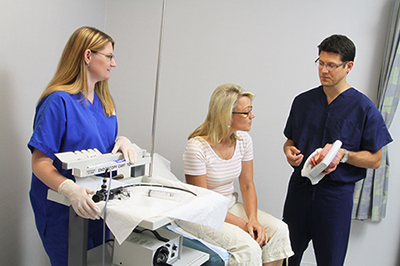Bladder Cancer
Bladder cancer is the sixth most common cancer in the United States. Over 81,000 people will be diagnosed with bladder cancer in 2019 and nearly 18,000 people will die of the disease. Most bladder cancers are urothelial carcinomas, though less common tumors, such as, adenocarcinoma, small cell carcinoma, and squamous cell carcinoma, can occur.
Signs/Symptoms of Bladder Cancer
The most common indication of bladder cancer is blood in the urine (hematuria). This bleeding can range from being visible to the naked eye to only being detectable on a chemical test and through microscopic analysis. Hematuria can be continually present or intermittent, and in most cases there is no pain; however, in rare cases, bladder cancer can cause lower back pain or difficulty voiding. There are many causes for blood in the urine other than bladder cancer, so it is important that one sees his or her urologist for a complete evaluation.
Other symptoms of bladder cancer may include changes in urinary frequency, increased urgency with urination, and burning with urination.
Risk Factors
Cigarette smoke is considered to be the leading cause of Bladder Cancer. Smokers have a three times greater incidence of bladder cancer than non-smokers, and up to half of all bladder cancer is a result of cigarette smoking. Other causes of bladder cancer can include certain industrial chemicals found in paints, solvents, tars, rubbers, and dyes.
Diagnosing Bladder Cancer
Blood in the urine requires several tests that often begin with some form of imaging of the kidneys, such as a CT scan or Renal Ultrasound. A complete evaluation also requires a cystoscopy performed by a urologist. If an abnormal area or growth is seen during the cystoscopy, a biopsy will be performed in which a small instrument is placed through the cystoscope to remove a piece of tissue for diagnosis. Complete tumor removal (transurethral resection of bladder tumor or TURBT) typically requires anesthesia. During the TURBT, the urologist passes a resectoscope into the bladder to remove tumors. Once the tumor has been removed, a pathologist examines the tumor to give a diagnosis.
Bladder Cancer Stages and Grading
Bladder tumor grade and stage are important for determining appropriate treatment. A grade (low or high) is given based on how abnormal the cells appear to the pathologist. High-grade tumors are more aggressive and can progress more quickly.
Staging is based on how deeply the bladder cancer is growing into the bladder wall tissues. The deeper a cancer, the more difficult and involved the treatments can be. Staging of the primary tumor (T stage) is as follows:
- Tis-carcinoma in situ (high-grade flat tumor confined to urothelium)
- Ta-noninvasive papillary tumor confined to urothelium
- T1-tumor invades lamina propria
- T2a-tumor invades superficial muscle
- T2b-tumor invades deep muscle
- T3a-microscopic perivesical fat invasion
- T3b-macroscopic perivesical fat invasion
- T4a-tumor invades adjacent organs (uterus, ovaries, prostate)
- T4b-tumor invades pelvic sidewall or abdominal wall
The N and M stages are also used to describe the status of the regional lymph nodes and other distant organs.
Treatments for Bladder Cancer
 Treatment options depend on the stage and grade of the tumor. For lower grade and lower stage tumors, often TURBT alone is used as treatment. Chemotherapy instilled into the bladder after a TURBT can be given to decrease the chance of tumor recurrence. The most commonly prescribed chemotherapy medicine is Mitomycin C. While generally well tolerated, Mitomycin C or other chemotherapy medicines can cause irritative urinary symptoms such as burning and pain with urination, frequency, and urgency, as well as skin rashes.
Treatment options depend on the stage and grade of the tumor. For lower grade and lower stage tumors, often TURBT alone is used as treatment. Chemotherapy instilled into the bladder after a TURBT can be given to decrease the chance of tumor recurrence. The most commonly prescribed chemotherapy medicine is Mitomycin C. While generally well tolerated, Mitomycin C or other chemotherapy medicines can cause irritative urinary symptoms such as burning and pain with urination, frequency, and urgency, as well as skin rashes.
Patients who are found to have higher grade tumors or stage T1 or Tis tumors are typically recommended to have a treatment course of BCG (bacillus Calmette-Guerin). This is an intravesical immunotherapy that is the most effective treatment for early-stage bladder cancer. BCG is instilled via a catheter into the bladder. This is performed in our office in just a few minutes and is given once a week for six weeks. Sometimes, long-term maintenance BCG therapy is given. BCG treatment side effects include flu-like symptoms, irritative urinary symptoms such as burning, frequency, urgency, and very rarely, high fevers and life-threatening infection.
Bladder cancers have a propensity to recur, and patients who have one tumor require long-term surveillance to monitor for cancer recurrence. This is typically done with regular office cystoscopies.
For bladder cancers that have invaded into the muscle wall or deeper, more radical treatment is required. The mainstay of this treatment is a radical cystectomy, which may also be recommended for patients with high grade tumors that have failed earlier treatments such as BCG.
Many patients who undergo a radical cystectomy are recommended to have courses of chemotherapy prior to surgery in order to maximize their chance of cure.
Patients who refuse radical cystectomy or who are too sick to undergo the surgery often have a bladder-sparing treatment. This most often involves combination treatment with chemotherapy and radiation. Chance of cure is lower with this approach though this still may be appropriate treatment for some patients.



